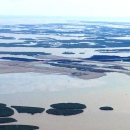About Us
Cat Island is located near the town of St. Francisville, Louisiana, 30 miles north of Baton Rouge. The refuge was established to conserve, restore, and manage native forested wetland habitats for migratory birds, aquatic resources and endangered and threatened plants and animals. The refuge lies at the southern end of Cat Island, which is not actually an island but rather a strip of low-lying land between the Mississippi River's current channel and the escarpment the river cut along the Tunica Hills as it meandered over time. Cat Island National Wildlife Refuge was established in 2000 as the 526th refuge in the National Wildlife Refuge System.
The refuge is periodically flooded by the Mississippi, and may remain flooded for several months of the year, with flooding typically starting in December and ending by June. The refuge’s sloughs and ponds, bottomland hardwood forests, and cypress-tupelo swamps offer abundant food resources for wading birds, a stopover for migratory waterfowl, and habitat for deer and many other native species.
The Tunica and Choctaw people have historic connections with the landscape and still live in Louisiana today.
Our Mission
The purposes for which the refuge is established and shall be managed are:
- to conserve, restore, and manage habitats as necessary to contribute to the migratory bird population goals and habitat objective [sic] as established through the Lower Mississippi Valley Joint Venture;
- to conserve, restore, and manage the significant aquatic resource values associated with the area’s forested wetlands and to achieve the habitat objectives of the ‘‘Mississippi River Aquatic Resources Management Plan;”
- to conserve, enhance, and restore the historic native bottomland community characteristics of the lower Mississippi alluvial valley and its associated fish, wildlife, and plant species;
- to conserve, enhance, and restore habitat to maintain and assist in the recovery of endangered and threatened plants and animals; and
- to encourage the use of volunteers and facilitate partnerships among the United States Fish and Wildlife Service, local communities, conservation organizations, and other non-Federal entities to promote public awareness of the resources of the refuge and the National Wildlife Refuge System and public participation in the conservation of those resources.
Other Facilities in this Complex
Cat Island National Wildlife Refuge is managed as part of the Southeast Louisiana National Wildlife Refuges Complex. The Southeast Louisiana Refuges are part of a rich ecological system which includes marshes, pine and bottomland hardwood forests, lakes, barrier islands, swamps and bayous. Ranging from the marshy delta at the mouth of the Mississippi, to the wetlands that help protect New Orleans from hurricanes and provide a nursery to the fisheries that support the region’s food economy, to the wild bayous of the Atchafalaya Basin; your Southeast Louisiana National Wildlife Refuges preserve wildlife, habitat, and recreation opportunities representative of this unique part of the country.
All of the Southeast Louisiana National Wildlife Refuges are open to public visits for nature-based recreational enjoyment. Priority public uses are hunting, fishing, wildlife observation, wildlife photography, environmental education, and interpretation.
The refuge complex headquarters is located at 61389 Hwy 434, Lacombe, Louisiana 70445. This site also hosts the Bayou Lacombe Visitor Center and has walking trails that wind through an historic garden site and along Bayou Lacombe.






